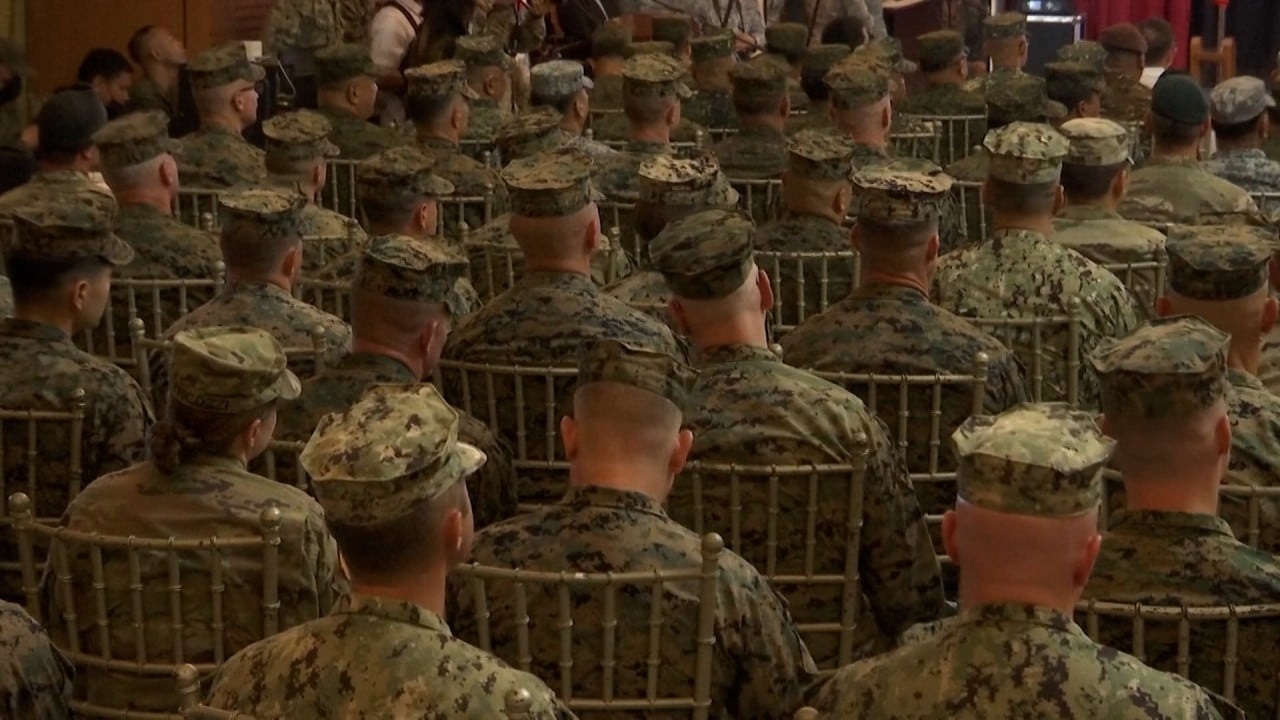
US-China military stand-off near Taiwan ‘no reason’ for Beijing to relax its guard
- Chinese state media claims PLA forces near Taiwan ‘scared off’ USS Nimitz but mainland defence experts say US may be buying time
- The Shandong and Nimitz aircraft carrier groups remained hundreds of nautical miles apart during the PLA’s six-day exercises
The USS Nimitz aircraft carrier and other warships remained several hundred nautical miles off eastern Taiwan during the six-day drills, showing Washington so far was not ready for a fight with Beijing, they said.
However, analysts warned that the US discretion might be aimed at buying more time to complete its comprehensive strategic deployment – with Japan, the Philippines, Vietnam and other countries in the region seen as important partners in countering Beijing.
According to an infographic posted on Twitter by the Beijing-based think tank South China Sea Strategic Situation Probing Initiative, the USS Nimitz circled its position, keeping a safe distance from the PLA’s Shandong aircraft carrier.

Many mainland media outlets claimed the USS Nimitz had been scared off by the Shandong carrier strike group’s 12,000-tonne Type 055 destroyer and its hypersonic anti-ship ballistic missiles.
PLA missile performance announcement read as warning to US
The advanced YJ-21 – also known as Eagle Strike 21 – has been deployed on Type 055 destroyers since February. Derived from the PLA’s “carrier killer” DF-21D, the YJ-21’s terminal speed of Mach 10 cannot be intercepted by any anti-missile weapons systems, according to early reports by Chinese state media.
On that occasion, state broadcaster CCTV claimed the USS Ronald Reagan aircraft carrier that escorted Pelosi’s flight retreated after the PLA Rocket Force set a missile shooting range to the east of Taiwan.
White House spokesman John Kirby immediately clarified that the Ronald Reagan had remained in the area “to monitor the situation”. He also announced that a planned test of a Minuteman III intercontinental ballistic missile was delayed to avoid increasing tensions.
CCTV also reported that the PLA had conducted “full tracking and surveillance” of the US Air Force transport plane that carried Pelosi and her delegation from Kuala Lumpur to Taipei on August 2.
At the time of the report, sources told the South China Morning Post that the USS Ronald Reagan’s electronic warfare systems had jammed the PLA’s J-16D aircraft and a number of warships at multiple locations to stop them tracking Pelosi’s flight.
Defence experts said the USS Nimitz and Shandong carrier strike groups would have engaged in similar contests between their electronic systems during last week’s PLA exercises.
The PLA’s unprecedented missile tests around Taiwan in August also raised tensions with Japan, when five of its missiles landed in the Japanese exclusive economic zone, which is not endorsed by Beijing.
Zhou Chenming, a researcher with the Beijing-based Yuan Wang military science and technology think tank, said the similar responses by the US aircraft carriers on both occasions were an indication of President Joe Biden’s political will.
What PLA’s latest Taiwan drills tell us about its military capabilities
Zhou said Washington was not ready for a fight with Beijing over Taiwan, preferring to focus on next year’s presidential election. With China-US relations a “big issue” for a Biden second term, the administration “would not allow the US military to take any risk”.
“The Biden administration might want to send a signal to Beijing that Washington would not further provoke Beijing over the Taiwan problem,” he said.
“[Biden] realises the US military is yet to possess all advanced conditions to beat the PLA in a possible war for Taiwan, even though the American force has … some tactical and technological advantages.”
Beijing-based naval expert Li Jie warned that Beijing should remain cautious as the US continued to work towards convincing its allies and partners in the region to join with Washington to deter Beijing’s “Taiwan reunification plan”.
Beijing regards the island as a breakaway province to be brought under mainland control – by force, if necessary. Many countries, including the US, do not officially recognise Taiwan as an independent state but oppose the use of force to change the status quo.
“The US has stepped up its strategic deployment in both the East and South China seas, a move that attempts to mix up the Taiwan issue with China’s territorial disputes with regional countries, especially Japan, the Philippines and Vietnam,” Li said.
“The trip by [US Secretary of State] Antony Blinken to Vietnam showed us that the US is going to break the PLA’s anti-access/area denial capabilities that the mainland has prepared for decades to stop foreign forces’ intervention in a possible Taiwan war.”
Speaking in Hanoi on Saturday, Blinken – who was on his way to the G7 foreign ministers meeting in Japan – said the time was “auspicious” to elevate the partnership between the US and Vietnam.
The Philippines and the US held their largest joint exercises in decades last week, after the PLA drills near Taiwan ended. Earlier in April, the Pentagon and Manila struck an agreement giving US troops access to four more military bases in the Philippines.



